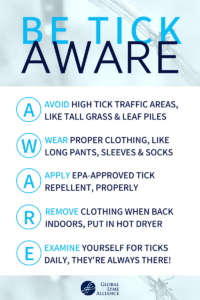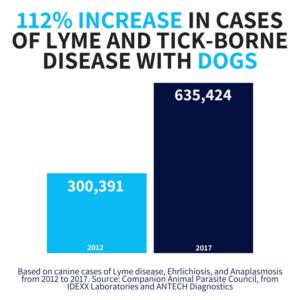
How to Prevent Lyme Disease (and Other Tick-Borne Infections)
How do I practice tick prevention?
Lyme disease is spread by the bite of the black-legged tick, also known as a deer tick, that is infected with bacterium borrelia burgdorferi and possibly other co-infections. An estimated 476,000 cases occur each year in the United States. If you camp, hike, work, or participate in outdoor activities, you could be bitten by an infected tick. Lyme disease prevention is one of the most important things you can do. Below are simple tips to help prevent Lyme disease.
Be Tick Aware

Practicing good tick bite prevention habits is the best way to prevent Lyme disease and other tick-borne illnesses. Good habits range from what clothing you wear, where you walk, and how often you check for ticks. Simply, it’s important to Be Tick AWARE.
AVOID tick-infested areas. Ticks thrive in wooded areas, leaf litter, tall grass, beach grass, bushy areas, stone walls, and perimeters where the lawn meets the woods.
WEAR light-colored clothing to spot ticks more easily; long-sleeved shirt tucked in at the waist, long pants tucked into high socks, closed-toe shoes, and a hat with your hair tucked in, if possible. Do not walk in the grass barefoot or in open sandals, even if it’s cut short.
APPLY EPS-approved tick repellent (such as DEET or picaridin), insect repellent, and insecticide (such as permethrin) to skin, clothing, and shoes as directed.
REMOVE clothing upon entering the home; toss into the dryer at high temperature for 10-15 minutes to kill live deer ticks. Putting them in the washer, however, will not.
EXAMINE yourself and your pets for ticks daily. Feel for bumps paying close attention to the back of knees, groin, armpits, in and behind the ears, belly button, and scalp. Check everywhere – ticks love to hide! Shower or bathe as soon as possible to wash away unattached ticks. If you find a tick, remove it quickly! The longer it is attached, the more likely it will transmit a disease.
Protect Your Pets
 Tick bite prevention is crucial for all members of your family, including pets. The risk to your dog of contracting Lyme or other tick-borne disease is on the rise. Research shows that cases of Lyme and other TBDs among dogs has increased 112% over the last five years (Companion Animal Parasite Council).
Tick bite prevention is crucial for all members of your family, including pets. The risk to your dog of contracting Lyme or other tick-borne disease is on the rise. Research shows that cases of Lyme and other TBDs among dogs has increased 112% over the last five years (Companion Animal Parasite Council).
This increased risk to our pets means an increased risk to you and your family, as ticks target both ends of the leash. If your pet, particularly dogs, goes outdoors they are at an increased risk for getting a tick bite. Add to that, your pet can serve as a tick taxi and will unwittingly carry ticks inside your home, exposing you and your family to a tick bite.
Ask your veterinarian about tick repellent products for your pets.
What to Do After a Tick Bite?
If you get a tick bite, don't panic! First, make sure you remove the tick properly. Once the tick is removed, it is best to send the tick to get tested. You will want to monitor both the bite site and reach out to a health care provider for preventative measures. if you start to see the typical symptoms of Lyme disease or other tick borne diseases, including flu-like symptoms, swollen lymph nodes, and joint pain, don't hesitate to call a Lyme specialist to receive a blood test. Listen to your symptoms and your body because, unfortunately, the current Lyme disease diagnosis can be inaccurate. For Lyme disease, the earlier the detection, the better!
Watch Video About Threat of Lyme Disease